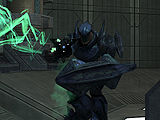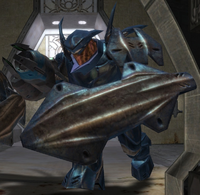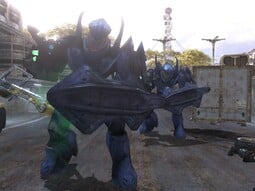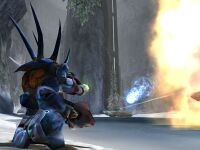Mgalekgolo
From Halopedia, the Halo wiki
Template:Covenant Species Infobox
The Mgalekgolo[1] (meaning "serpent union"[2]) are a unique gestalt of smaller creatures known as Lekgolo, small worm-like beings that can group together to geometrically increase intelligence, strength, and maneuverability.
Background
When their home world of Te was visited by the Covenant, whom intended on mining the world, they faced heavy resistance from the Hunters whose physiology gave them a tremendous advantage in combat. The Covenant were further infuriated by the Hunter's destruction of Forerunner artifacts during their routine feedings.[3] Hunters were later forced into the Covenant by the superior starship technology of the Elites--on the ground they were mostly, if not always, victorious. Near extinction because of orbital bombardment,they then decided to join the Covenant.
This time later came to be known as the Taming of the Hunters. Terms for their induction into the Covenant were eventually met despite communication difficulties, which hampered the process. In their agreement to join with the Covenant, the Lekgolo worms, which fed on specific minerals, were consigned to investigate the Forerunner Dreadnought that resided in High Charity and help uncover its inner-workings. Their price for this trade was access to space-travel technologies and exploration of the Covenant space lanes.
When a single colony of Mgalekgolo becomes too big, the colony will divide in half to create two independent Mgalekgolo colonies. These colonies will share an extremely close and mysterious bond, referred to only as being "bond brothers" or "Mates".[4] Mgalekgolo that have split into "bond brothers" are recognized by spiked appendages that rise from their shoulders, which means that they are bonded to another Mgalekgolo.[5] Bonded Mgalekgolo colonies are dropped into battle together by the Covenant, and if one of the bonded colonies is killed, the other will go into a frenzied state.
During the Battle of Onyx, some Hunters had command of lower ranking Sangheili, signifying they may have a higher military rank in the Covenant military then previously indicated.
Description
Hunters take a hulking bipedal form in the Covenant military.[6] In this form, they are the strongest and most resilient species in the Covenant [7] These forms stand between twelve and thirteen feet tall, but when in their combat state they crouch to approximately eight to nine feet, diminishing their visible unarmored stomach and neck. Their armor has a blue luster that is makes the orange-red skin of the Lekgolo worms inside very noticeable.
Hunters fight with Assault Cannons integrated directly into their armor, and they carry an enormous and nearly-impervious metal shield made of an unknown alloy derived from the same component that forms Covenant starship hulls. This Shield protects them from almost every form of plasma-based or ballistic weaponry available to Covenant and Human infantry alike, and is a powerful melee tool capable of crushing anything in it's path and allowing the Mgalekgolo to sweep away any enemies in close combat.
The Assault Cannon the Hunter wields operates in two modes; one firing a single explosive capsule of incendiary fluid, the other spraying the fluid out in a 'beam'. Few opponents can withstand the power of this weapon.
Culture
Malekgolo almost never associate, or even communicate, with other Covenant client races, save for the Sangheili. They are dismissive, scornful and arrogant to the "lesser" Covenant races like Unggoy and Kig-Yar and are utterly contemptuous of their foes. Many of the Covenant are mystified and confused by the Mgalekgolo and indeed their way of life is almost as alien to them as the Flood. A Sangheili Fleet Master has noted that they were known them to tear opponents apart with their "bare hands" whilst in a blood frenzy and then pause to recite war poetry.[8] During the Covenant Civil War, most Hunter pairs sided with the Sangheili and the Covenant Separatists. No reason for this is known yet, but it is likely due to their deep respect for the Elites from the events of the Taming of the Hunters.
Naming
Hunters have three names: personal name, bond name and line name. The personal name is given at their birth. The line name represents the genetic heritage, being the name of the most successful Mgalekgolo of his ancestors. If one reaches a certain level of status, his offspring will have his personal name as their line name. The bond name is taken between bonded pairs, colonies that must split into two due to excessive size. Examples of some Hunter names include Igido Nosa Hurru and Ogada Nosa Fasu.
Anatomy and Physiology
Mgalekgolo are not singular organisms, but rather are composed of multiple small, orange, eel-like beings that form a singular collective consciousness and act as one. In other words they are a communal organism working together to perform specific tasks. Mgalekgolo are capable of manifesting in several different iterations according to what goal they are striving to achieve and the amount of Lekgolo worms present. The Hunter is the most common form seen in combat during the Human-Covenant War, but is one of the rarer forms in the Lekgolo society. This Mgalekgolo is employed by the Covenant as heavy infantry. Their society is predominated by this combination of being to create exponentially more intelligent creatures, and the actual "Hunter" organism is one of the rarer and smaller forms to be found, used primarily in interaction with the Covenant hierarchy. The almost indestructible armor that covers them serves the dual purpose of protecting the eels and keeping them together.
When a single colony of Mgalekgolo becomes too big, the colony will divide in half to create two independent Mgalekgolo colonies. These colonies will share an extremely close and mysterious bond, referred to only as being "bond brothers" or "Mates".[9] Mgalekgolo that have split into "bond brothers" are recognized by spiked appendages that rise from their shoulders, which means that they are bonded to another Mgalekgolo.[10] The white streak on the Hunter's "head" is actually a visor or sensor screen.

Because of their make up of several eels instead of being a singular large organism, the Lekgolo are one of the only species in the Covenant that cannot be assimilated by the Flood, as their unique physiology does not allow the organism to access a Central Nervous System or control them to any capacity. As such, there has never been a Hunter Combat Form, though it is thought that the flesh of the Lekgolo can and is likely used by the Flood simply for its biomass.
The collection of eels that make up a Hunter's body are unintelligent at the most basic level, but can form complex thoughts and emerge as a conscious individual when they combine into larger masses that communicate through chemical and electrical means.
The neural net that Hunters develop enables them to be incredibly strong and sensitive to all things within a 1000 foot line pointing out from non-combat form, and a half sphere that extends 500 feet in combat form. Hunters generally growl during battle but will sometimes talk and make remarks like the other Covenant species. Instead of using vocal chords, they vibrate their bodies to make a low rumble that is described as "more felt than heard" to produce speech.[11]
It is theorized that Hunters reproduce asexually similar to earthworms; however, there is, as yet, no way to be certain.
Religion
It has actually been mentioned that the Lekgolo do not believe in the Great Journey, which is the main belief in the Covenant religion. The only reason that they associate with the Covenant, is to take advantage of their advanced technology. In fact outside of fighting, the Lekgolo do not take part in any Covenant religious actions. It is also because Sanghelli tamed them and hunters always and only follow Sanghelli's command.
Combat
Halo: Combat Evolved
A Hunter's armor is extremely resilient and is immune to most small arms fire, as the ammunitions does nothing but bounces off from it.
However, they do have an exploitable weak spot (in which it will take one pistol/sniper shot to kill): the exposed orange flesh located in their midsection's and necks. While they keep the exposed areas on the fronts of their bodies well-covered with their shields, rarely giving the player an opening unless the Hunter tries to melee them, the creature's backs have a large exposed area that is extremely vulnerable. However, if you shoot a rocket at them, it does not matter where are you aiming, it will kill with one shot (unless you are in Legendary Mode, in which case it may take two rockets).
In addition, while not on alert to an enemy's presence they assume a stance where their neck and midsection is especially vulnerable. While firearms are incapable of penetrating a Hunter's armor, it cannot stand up to heavy weapons such as rockets and artillery.
In Halo: Combat Evolved, Hunters were rarely difficult to defeat; their AI was simplistic, their shots and melees slow and awkward, and they could barely move fast enough to run down a back-pedaling Spartan, making their melee very easy to dodge, allowing you to kill them rather easily.
Interestingly in Halo PC, if you don't move from your position while the Hunter is firing at you, it will never hit you with its Assault Cannon. Furthermore, they could be killed by a single shot from the M6D Pistol, as long as it hit the exposed orange area in the middle of the body or the similarly unarmored "neck".
Other weapons, especially the shotgun and sniper rifle for very short and very long distances, respectively, were equally deadly. The rocket launcher was always effective, but never particularly necessary. Grenades were only moderately effective, as the Hunter could withstand a half-dozen grenade blasts.
Plasma weapons were often ineffective, as was the Needler and the MA5B Assault Rifle took so long to make a kill that other weapons were far more useful. Still, no player with even a modicum of skill feared confronting a Hunter on open ground.
On Legendary, some players regarded Hunters as the least challenging enemies in the game (killing them is rarely a difficulty, even when armed with the most inappropriate of weapons). However, inexperienced or careless players can fall victim to the Hunters' attacks, which, while easy to anticipate, are rather powerful.
A unique way to kill a hunter (which does not work in Halo 2 or Halo 3) is to melee it over and over again and can be done to the front of the Hunter. But is highly recommended to hit from behind. Since it is easier for them to attack whats in front of them; simple.
However, Hunters really gained the upper hand in the cramped hallways of the Truth and Reconciliation and the Pillar of Autumn, where there was little space to dodge the fuel rods or crushing melee blows and no room to utilize either a sniper or rocket launcher to defeat them. Still, these levels were full of shotgun or pistol ammo and these weapons are reasonably useful against Hunters at close range, especially the pistol.
If one were to stand far away from the Hunter, it might bring to bear its Assault Cannon. However, it's projectile has a low velocity, and as such, is very easily dodged. It is also easy to anticipate, as the barrel of the weapon glows bright green before firing. If one were in melee range of the Hunter, it might also wield its shield in as a powerful melee weapon, resulting in serious injury, if not death for the intended target. However, these attacks can be, at most times (unless you say... back pedal into a wall), simple to avoid.
On certain levels, it is possible to defeat Hunters by standing in front of a cliff and then sidestepping them as they attempt a melee attack. If timed correctly, the Hunter, unable to stall its momentum, will fall from the precipice to its death.
Lining up hunters so that they shoot themselves is dangerous, difficult, and not very rewarding, and it is not advised because killing is rather simple on most levels, even on legendary.
Halo 2

The Hunters have undergone a number of changes for Halo 2. For example, they will actually react to the loss of their bond brother. While they appear in fewer numbers, they are tougher and more dangerous. They are also invulnerable to melee attacks, whereas in Halo: Combat Evolved, all it took to kill a hunter was to melee it persistently.
The most notable change is their new weapon: although similar to the old Assault Cannon, the new Assault Cannon fires a continuous beam of green plasma rather than an arcing projectile. This new weapon is more damaging if not dodged carefully.
In addition, the Hunters are over 25% larger[12] and faster, making combat against them much more hectic. Fortunately, all these go towards your advantage when playing the Arbiter; the Hunters are then powerful and durable allies.
They have gained a new move, too: the ability to attack an enemy behind them. This effectively makes the old strategy of "dodge-and-fire" far less effective.
Finally, the Hunters have much more health. Most small arms do rather moderate damage against them, in contrast to the M6D's ability to kill them in a single shot. For example, on Normal difficulty, it takes 13 shots from the M6C Magnum Sidearm, 6 full bursts from the Battle Rifle, or 10 shots from the Covenant Carbine to kill a Hunter.
On Heroic and lower difficulties, sniper weapons will kill a Hunter in a single shot. However, on Legendary, not a single weapon (except, of course, the Scarab Gun, which is never present during a fight with Hunters anyway) can kill them in one hit. Even a SRS99C-S2 AM Sniper Rifle or Beam Rifle will take two shots to kill a Hunter on Legendary.
Often, the most effective weapon against them is the one that does the most damage: the Rocket Launcher is greatly effective, as is the Fuel Rod Cannon. While these weapons take two and three shots respectively to kill a Hunter on Legendary, they can damage one regardless of where it hits it.
Grenades still do little damage against Hunters and it will usually take a large amount of them to take one down. However, grenades, hand held or fired from the Brute Shot, will disorient a Hunter, giving the player an opportunity to shoot at its exposed flesh. Perhaps the most effective method to defeat a Hunter would be to stick a plasma grenade to it and shoot it in its exposed back with a beam rifle or sniper rifle, as a plasma grenade in this fashion will make the Hunter do a 180 degree turn or freeze on the spot.
Hunters are equipped with an extremely devastating Assault Cannon melded into its arm. Unlike a normal Fuel Rod Cannon, Hunters with their cumbersome bulk and strength are able to withstand the recoil and produce a more lasting and lethal blast.
If an enemy gets too close, the Hunter will attempt a clumsy but dangerous melee attack with its shield, severely injuring if not killing the enemy. Once its partner is killed, the Hunter becomes much more aggressive and will chase the player, attempting to avenge its partner's death by only melee attacks.
When battling the UNSC Marines, one hunter will engage the Marines in close combat, whilst the other will hang back and support with the Fuel Rod Gun. If one of the Hunters die, the other occasionally will leap forward and attempt to smash an enemy with its shield. If this attack connects, the foe on the receiving end of the blow will invariably die.
Halo 3

The Hunters in Halo 3 are further upgraded from their Halo 2 counterparts. They are even larger and much stronger, but appear less bulky.
Their previously vulnerable "stomach" areas are covered by armor plating. All melee attacks are faster and much deadlier, and these Hunters now anticipate enemies behind it and can attack them. But their armor is more interactive, so if back plating is removed, there will be a bigger target to shoot at. (The spines are also prone to falling off).
If a grenade is thrown at a hunter, it can strafe-jump away from the explosion. However, their spikes and back armor now falls off in pieces as the Hunter accumulates damage, and their Assault Cannons do slightly less damage, while it appears that grenades and explosives seem to do more damage compared to the other two games. Gravity Hammers can also do a great deal of damage if hit in the exposed part of their back.
Even on Legendary, a single Spike Grenade can kill a Hunter if properly stuck on their shield, so that the direction of the spikes will penetrate directly into the Hunter. The most effective weapons against them are Support Weapons and Explosives.
In-game Appearances
Halo: Combat Evolved
Truth and Reconciliation
The Silent Cartographer
Assault on the Control Room
Two Betrayals
Keyes
The Maw
Halo 2
Outskirts
Regret
Gravemind
The Great Journey
Halo 3
The Storm
The Ark
The Covenant
Trivia
- Hunters were first seen by the UNSC in 2537 in Operation: PROMETHEUS.
- Hunters are responsible for security aboard a Covenant warship. One of their duties is to protect the vessel's Ship Master. Upon failing that, they are to enact revenge on his assassin.[13]
- In Halo: Combat Evolved, if you fire an Assault Rifle into the orange area on the Hunter's back, not only will orange blood come out but also Flood blood. The reason for this is unknown.
- In Halo: Combat Evolved, the level Assault on the Control Room has a total of 12 Hunters when played on Legendary. The most on any level in the whole trilogy.
- In Halo: Combat Evolved, the level The Silent Cartographer level is the second level to have the most Hunters; 8 Hunters.
- In Halo: Combat Evolved, if you look closely at a hunter the orange fleshy parts glow in an on and off pattern. This can be seen more easily in a dark place.
- Halo 2 and Halo 3 Hunters will flex their spines upon sighting the Master Chief, unlike their Halo: Combat Evolved counterparts.
- In Halo 2, it is possible to play as a Hunter due to a glitch.
- As of Halo 3, despite the Elites possessing Grunt and Hunter allies of their own, neither appear as anything but enemies in the game.
- In Halo: The Flood, it mentions that Hunters have skin and a jutting spine. This is incorrect, however, as they were revealed to be a compound of little worm-like entities. The writer most likely could have been referring to the skin and pseudo-skeleton of an individual worm, or the worm compound fact had still to be revealed. In Halo 3, a metallic "spine" can be seen after killing a Hunter, perhaps explaining this anomaly.
- In Halo: Combat Evolved on the Maw (only on Normal difficulty or higher), the Hunters that run out of the café room will occasionally have gray stomachs and grayed armor on their back and spines, as well as a "burned" appearance. It is unknown if this is just a texturing glitch, a model mix up like the "Honor Guard Councilor" at the end of Gravemind, or to show that the Hunters have been in combat for a long time.
- At first, Hunters were meant to comprise the whole of Heretic forces on the Gas Mine.[14]
- Ophis means snake. Congregatio means assembly, society, union. Translated it means "assembly of "snakes", identifying their physical structure.
- In a Bungie Weekly Update, Frank O'Connor said: "Hunter society is complex and we have seen but the tiniest fraction of it. There are some fundamental facts about Hunter biology that mean the combat type is just the tip of the iceberg". [15] This means, or at least implies, that there are other kinds of Hunters that simply have yet to be seen.
- Spartan William-043 wounded a Hunter by ripping out the worms in its body, hinting that Hunters can be killed if too many worms are displaced.
- It is speculated that the Scarab from Halo 3 is actually a giant machine controlled by the Lekgolo worms. Many things support this, such as the lack of actual driver for the vehicle, as well as the orange core in the back that resembles Lekgolo worms and bleeds orange when shot.
- In Halo 3, if one shoots a dead Lekgolo's exposed orange spots, small blackened worms will fly out.
- In Halo: Combat Evolved, if you look at the head of a Hunter it appears as if it has eyes.
- In the Book Halo: The Fall of Reach, Master Chief first deduces the Covenant's caste system when he sees a Jackal that had been crushed to death by a Hunter's boot.
- It is impossible to kill a hunter with an Energy Sword or Brute Shot melee(except in Halo 3), even though, in theory, it should be able to slice and kill the worms.
- The Hunter resembles the hunter enemy from Bungie's older series, Marathon, with the exception of the weapon being mounted on the arm, as opposed to the shoulder.
- Despite the Hunters not being able to be assimilated by the Flood, many thought that the deleted Flood Juggernaut was the Hunter Form.
- Jason Jones described the orange spots on Hunters as being they're special areas and that they don't like to be shot in their areas.
- Despite being impervious to Flood infection, in Halo: Combat Evolved, Hunters can be wounded when Infection Forms latch onto their backs.
- In Halo 2 and Halo 3, you never encounter Hunters while fighting the Flood.
- In Halo: Combat Evolved, one shot to the Lekgolo of the Hunters body by a M6D is an instant kill.
Gallery
- 1210404018 2170450642 7d47a8bc44.jpg
- 1210404002 2169655245 1f2b864e76.jpg
- 1210403895 Hunter.jpg
- 1210403868 Outskirt hunters adj.jpg
- 1210403846 1460160014 4a511d0f00.jpg
See Also
Sources
- ^ Bestiarum
- ^ HBO Forums
- ^ Cite error: Invalid
<ref>tag; no text was provided for refs namedHalo: Contact Harvest - ^ Halo: The Flood
- ^ Halo: Contact Harvest
- ^ Cite error: Invalid
<ref>tag; no text was provided for refs namedBestiarum - ^ Halo 3 Game Guide, http://www.microsoft.com/silverlight/halo3.aspx, On Covenant character page.
- ^ Ghosts of Onyx
- ^ Halo: The Flood
- ^ Halo: Contact Harvest
- ^ Halo: Ghosts of Onyx, pages 190-191
- ^ The Art of Halo, Creating a Virtual World
- ^ Halo: Ghosts of Onyx, page 190
- ^ "Essentials - Disk Three"
- ^ http://www.bungie.net/News/TopStory.aspx?story=updatefeb03
